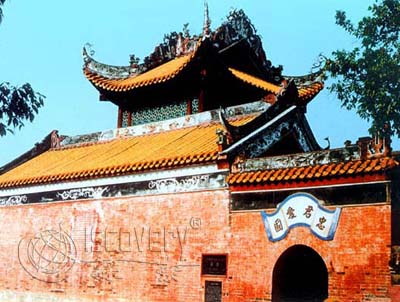Gongcheng Martial Temple (2) - Historical and Cultural Figures of Guilin
Guilin is a historically famous city with a brilliant and splendid culture. The beauty of Guilin's landscape is known all over the world, giving Guilin's tourism culture another globally recognized brand.
The Wu Temple architecture consists of a stage, main hall, Xietian Palace, rear hall, and east-west wing halls. The entire building has double-eaved歇mountains, with upturned eaves corners. The roof ridge decorations are made of clay sculptures, featuring dragons and phoenixes symbolizing good fortune, as well as the Eight Immortals in both visible and hidden forms, and lifelike human figures and birds. The yellow and green glazed tile roofs blend with the brilliance of the Confucius Temple, forming a glittering sea under the Yinsan Mountain.
The Wu Temple stage is one of the two best-preserved ancient stages in Guangxi (the other being in Huangyao Ancient Town in Zhaoping County). Despite having endured four centuries of vicissitudes, it still retains its charm.
Guan Yu, surnamed Guan and named Yu, with the courtesy name of Yun Chang, died in battle against the Wu Kingdom and was posthumously honored as Marquis Zhuangmou. Locals built a temple on Yüquan Mountain to worship him. However, his influence among the common people wasn't significant until the Tang Dynasty. By the end of the Northern Song Dynasty, he was honored as Lord (some say as True Lord). Due to Guan Yu embodying loyalty, bravery, benevolence, and righteousness: his loyalty to the state, bravery in battle, benevolence in dealing with others, and righteousness towards people, almost encompassing all the virtues of the Chinese nation, his influence grew increasingly larger. He was eventually revered as Emperor Guan, commonly known as Lord Guan. Both Buddhism and Taoism vied to include Guan Yu as a deity in their respective religions. In Buddhism, he is regarded as a Dharma Protector, while in Taoism, he is seen as an incarnation of an old dragon from Lei Shou Mountain, respected as True Lord. After the Ming and Qing Dynasties, Guan Yu became the chief among deified humans, ranking alongside Confucius, the "Sage of Literature," as the "Saint of Martial Arts." In folk traditions, the reverence for Guan Yu across various professions even surpasses that for Confucius. Since the Ming and Qing Dynasties, Guan Yu has become the martial god and war god who protects the homeland, the patron saint of various industries, the star of success in examinations and promotions, the wealth god who blesses merchants with prosperity, and the righteous and fortunate god who removes calamities, drives away evil spirits, and punishes traitors. Now, Guan Yu's influence has transcended time and space, as well as national boundaries, receiving worship and respect from descendants of the Yan and Huang emperors around the world.
